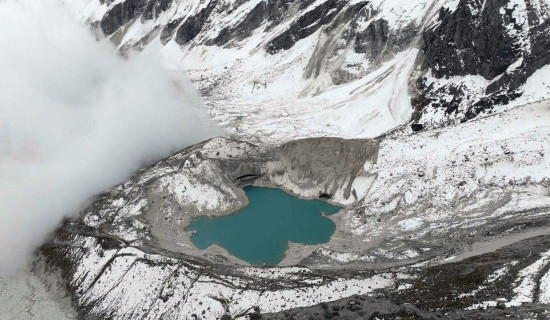- Thursday, 16 October 2025
Lesson From Thame Flood
A glacial lake outburst has caused a devastating flash flood in the Khumbu region of Nepal. After the authorities' aerial inspection of the area, it was confirmed that the flood occurred due to the outburst of two glacial lakes up in the mountains. The devastation caused by the glacial lake outburst in the Thame region rings an alarm bell to work to avoid such catastrophes in the future. The devastating flood swept away 20 houses, a school and a clinic in ward No. 5 of Khumbu Pasang Lhamu Municipality. There are a total of five glacial lakes above the Thame settlement, and among the remaining three, two are still at risk of outbursts. More than 135 people in the region have been displaced after the disaster.
As per scientific studies, glaciers in the Hindu Kush Mountain Range are melting at an alarming rate. The report says glaciers in the Hindu Kush Himalaya range have melted 65 per cent faster in the 2010s compared to the previous decade which shows that global warming has started showing its effect. Rapid melting of snow and glaciers leads to the formation and expansion of the glacial lakes. When their surrounding debris can no longer hold them in place, it leads to the outburst of the lake, causing massive floods downstream. According to scientists, the volume of glacial lakes has increased by 50 per cent in the period of 30 years.
Melting of glaciers is the major source of fresh water for most countries including Nepal, India, and China. Rapidly melting of ice in the Himalayas pose the threat of not only glacial lake outbursts but might also cause waster scarcity in the long run. This is a serious problem, caused by the global warming, to mountainous countries like Nepal. Nepal should learn from the catastrophe of this magnitude at Thame, which destroyed infrastructures and displaced hundreds. The catastrophe occurred during the day time, so the casualty was minimum. At night time, it could have claimed larger number of lives. Glacial lake outburst flood is not just an alarmist theory as proved by this event but a looming reality and Nepal has highlighted this threat in international forums.
Tourism remains an important source of national revenue. Mountains are major attraction for tourists visiting Nepal. However, catastrophes like this in the Himalayan region may lead to a significant fall in the number of tourists. Likewise, floods like this threaten the fragile ecosystem of mountainous regions and communities that are dependent on mountains for their subsistence. In the event of such a catastrophe settlements, powerhouses, roads, bridges and other infrastructure are likely to be damaged. An early warning communication system needs to be put in place to save lives and vital belongings. This event must teach us valuable lesson for safety measures for the future.
Nepal's share in global emission of greenhouse gases is negligible but it is paying high prices of global warming. Along with a strong global commitment to curb the devastating impacts of climate change, the government should increase its funding to monitor these lakes, conduct research and implement sustainable risk reduction strategies for the future. We should be able to claim money from global climate funds for such a purpose. Based on risk-related studies, river side settlements and marketplaces need to be shifted to safer locations.

















